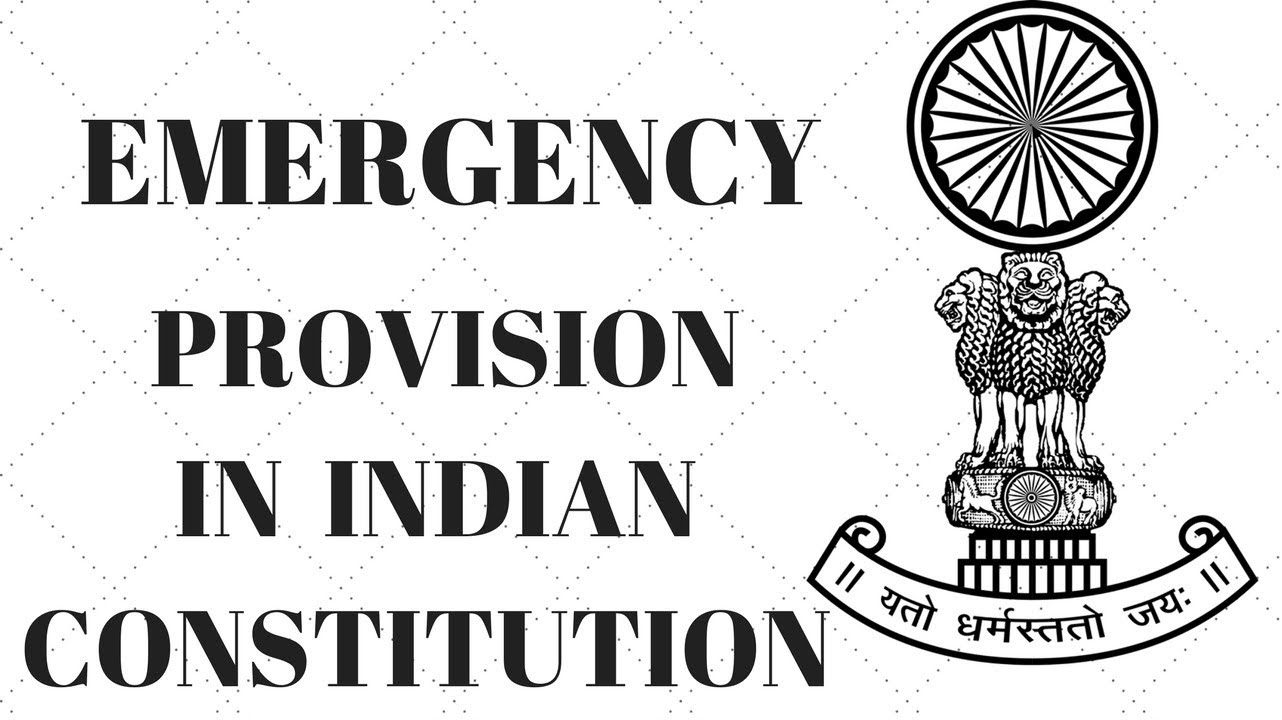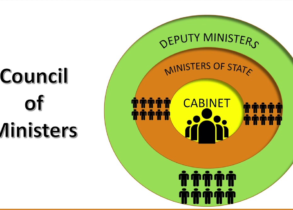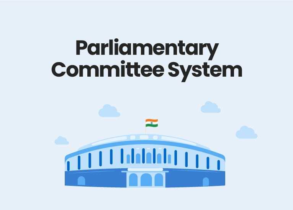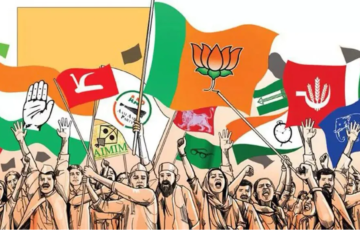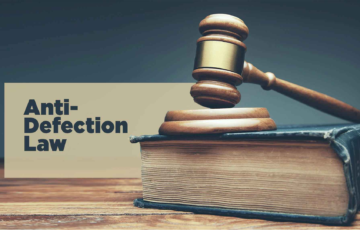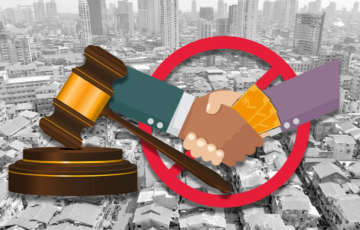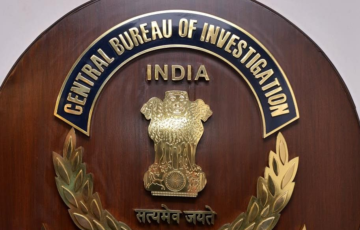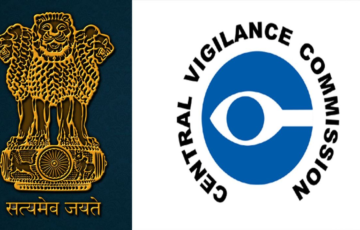EMERGENCY PROVISIONS
Introduction
- An emergency is indeed an unforeseen or unexpected situation that necessitates immediate government action within its prescribed powers. Emergencies often result from the breakdown of normal administrative mechanisms and may include situations such as natural disasters, armed conflicts, or other crises that threaten the security or stability of the state.
- The Indian Constitution contains a detailed set of provisions in Part XVIII (Article 352-360) that pertain to emergencies. These provisions are designed to protect the sovereignty, unity, integrity, and security of the country during times of crisis. They grant certain extraordinary powers to the federal government to address these critical situations. The Indian Constitution stipulates three types of emergencies:
- National Emergency
- Constitutional Emergency/President’s Rule
- Financial Emergency
| Reasons for adoption of Emergency Provisions |
During the discussions in the Constituent Assembly of India, various reasons were put forth to justify the adoption of provisions related to the Emergency in the Constitution. Some of the key reasons cited include:
|
National Emergency
Grounds for Declaring a National Emergency
- A National Emergency can be declared under Article 352 of the Indian Constitution when the security of India or a part of it is threatened by war, external aggression, or armed rebellion. The President can proclaim a National Emergency if there is an imminent danger of any of these events, even before they have actually occurred.
- Types of National Emergency: A National Emergency can be categorized into two types:
- External Emergency: Declared due to “war” or “external aggression.”
- Internal Emergency: Declared due to “armed rebellion.” The term “armed rebellion” was introduced by the 44th Amendment, replacing the earlier term “internal disturbance.”
- Territorial Extent: A National Emergency can be declared over the entire territory of India or limited to a specific part of India. The 42nd Amendment Act of 1976 empowered the President to restrict the operation of a National Emergency to a specific area.
- Declaration with Cabinet’s Advice: The President can declare a National Emergency only on the written advice of the Council of Ministers, which includes the Prime Minister and other ministers. This means that the declaration of an emergency requires the approval of the cabinet and cannot be solely based on the Prime Minister’s recommendation.
Parliamentary Approval and Duration of National Emergency
- Ratification by Parliament: A National Emergency must be ratified by both Houses of Parliament within one month of its declaration. The 44th Amendment Act of 1978 shortened the original two-month period for approval.
- Approval Process: The approval of a National Emergency requires a special majority in both Houses of Parliament, which means it must be passed by a majority of the total membership of each house and by a majority of not less than two-thirds of the members present and voting.
- Duration and Renewal: If approved by Parliament, a National Emergency remains in force for six months from the date of approval unless revoked earlier. It can be renewed and approved by Parliament any number of times but not beyond six months at a time.
- Lok Sabha Dissolution: If the Lok Sabha is dissolved at the time of the proclamation, or if its dissolution occurs during the one-month period without approval, the proclamation can continue until 30 days from the first sitting of the Lok Sabha after its reconstitution, provided the Rajya Sabha has approved it.
- Judicial Review: The proclamation of a National Emergency made by the President is subject to judicial review. The constitutionality of the proclamation can be challenged in a court of law, particularly on the grounds of malafide intentions.
Revocation of Proclamation of National Emergency
- Revocation by the President: The President of India has the authority to revoke a National Emergency at any time during its continuance by issuing another proclamation. This revocation does not require approval by Parliament.
- Revocation on Lok Sabha’s Disapproval: The 44th Amendment Act introduced a significant change in the process of revocation. It mandated that if the Lok Sabha (House of the People) passes a resolution disapproving of the continuation of the National Emergency by a simple majority, the President must revoke the emergency.
- Lok Sabha’s Disapproval Resolution: The Lok Sabha has the power to disapprove the operation of a National Emergency at any time. If not less than one-tenth of the members of the Lok Sabha issue a notice with the intention of disapproving the emergency, the President must take this into consideration.
- Special Sitting of Lok Sabha: If the Lok Sabha is not in session when such a notice is issued, a special sitting of the Lok Sabha shall be held within 14 days for the purpose of considering the resolution to disapprove the National Emergency.
Impact of National Emergency
On the Executive Front:
- The President of India can issue directions to the states regarding the manner in which the executive powers of the states are to be exercised.
- State governments are not dismissed, but they come under the effective control of the central government during a National Emergency.
- The central government assumes the power to give instructions to the state government, which must comply with these directions (Article 353A).
On the Legislative Front:
- State legislatures continue to operate and can legislate during a National Emergency.
- However, Parliament gains concurrent legislative power on state subjects, allowing it to enact laws on matters typically under state jurisdiction.
- These laws enacted by Parliament will cease to operate six months after the revocation of the National Emergency, to the extent of their incompatibility with state laws (Article 353B).
On Financial Relations:
- The financial relations between the center and states, as outlined in Articles 268-279, may be modified by presidential order during a National Emergency, subject to parliamentary approval.
- These modifications are limited to the financial year in which the emergency is revoked.
- The President can suspend the distribution of financial resources between the center and states, and the central government can utilize national resources to cover the costs associated with the reasons for declaring the emergency.
On Life of the Lok Sabha and State Assembly
- The life of the Lok Sabha, which has a regular tenure of five years, can be extended by a law of Parliament during a National Emergency.
- These extensions can go beyond the regular five-year period, for any number of years, while the National Emergency is in effect.
- However, the extension is valid only for up to six months after the National Emergency has been revoked.
- For example, the Fifth Lok Sabha’s tenure (1971–1977) was extended twice, each time by an additional year.
- Similarly, state legislative assemblies, which also have a regular tenure of five years, can be extended for up to one year each time during a National Emergency, but subject to a maximum of six months after the Emergency has ceased.
Effect on Fundamental Rights:
- Article 358 deals with the suspension of the Fundamental Rights guaranteed by Article 19, but this suspension applies only when a National Emergency is declared on the ground of war or external aggression and not for armed rebellion.
- Article 359 authorizes the President to suspend the right to move any court for the enforcement of fundamental rights during a National Emergency, except for the rights guaranteed by Article 20 and Article 21.
| Instances of National Emergency declared so far in India |
|
Amendments Related with National Emergency
38th Constitutional Amendment Act, 1975:
- This amendment empowered the President to proclaim a National Emergency on different grounds, even if an emergency is already in operation.
- It made the declaration of a National Emergency immune to judicial review. However, this provision was subsequently deleted by the 44th Amendment Act of 1978.
39th Constitutional Amendment Act, 1975:
- This amendment was a response to a judgment by the Allahabad High Court that declared Prime Minister Indira Gandhi’s election to the Lok Sabha void.
- It removed the President, Vice President, Prime Minister, and Speaker of the House of Representatives from the jurisdiction of the judiciary, allowing their matters to be decided by authorities designated by Parliament.
42nd Constitutional Amendment Act, 1976:
- This amendment empowered the President to modify or vary the National Emergency. Originally, only imposition or revocation was possible.
- It expanded the President’s authority to declare a National Emergency over a part of the country, rather than just the entire territory.
44th Constitutional Amendment Act, 1978:
- Enacted to prevent the misuse of emergency powers by the executive, this amendment introduced several safeguards to Article 352.
- It replaced the vague term “internal disturbance” with “armed rebellion” as one of the grounds for declaring a National Emergency.
- It changed the approval process, requiring a special majority in Parliament for the proclamation of emergency.
- It introduced parliamentary control by allowing a special sitting of the Lok Sabha for the purpose of considering disapproval of the emergency.
| Important Judgements |
Minerva Mills Case (1980):
Distinction between Articles 358 and 359 (Makhan Singh Case):
Validity of the 39th Constitutional Amendment Act (1971):
|
President Rule
Grounds of Declaration
- The President of India can impose President’s Rule on a state under Article 356 of the Constitution of India on two grounds:
- Failure of constitutional machinery in the state: This means that the state government is unable to function in accordance with the provisions of the Constitution. This could be due to a number of factors, such as:
- A breakdown of the law and order situation
- A political crisis, such as the resignation of the Chief Minister or the collapse of the government’s majority in the state assembly
- A failure of the state government to uphold the fundamental rights of its citizens
- Failure of the state government to comply with the directions of the central government: This means that the state government has refused or neglected to carry out the orders of the central government on matters that fall within the Union’s jurisdiction.
- The President can impose President’s Rule on a state even if the state government has not explicitly requested it. However, the President is required to issue a proclamation explaining the reasons for imposing President’s Rule. The proclamation must also be approved by both houses of Parliament within a period of 30 days.
- Once President’s Rule is imposed on a state, the state government is suspended and the central government takes direct control of the state administration.
Parliamentary Approval of President’s Rule
- Article 356 of the Constitution of India states that the President’s Rule proclamation must be approved by both houses of Parliament within two months of its issue. If the Lok Sabha has been dissolved or is dissolved during the two-month period, the proclamation must be approved by the Rajya Sabha within 30 days of the first sitting of the Lok Sabha after its reconstitution.
- If the proclamation is not approved by Parliament within the specified time, it lapses and President’s Rule comes to an end.
Duration of President’s Rule
- President’s Rule can initially last for a period of six months. It can be extended for a maximum of three years with the approval of Parliament every six months.
- In order to extend President’s Rule beyond one year, the following conditions must be met:
- There is a national emergency in India.
- The Election Commission of India certifies that it is necessary to continue President’s Rule in the state because of difficulties in conducting assembly elections to the state.
History of President’s Rule
|
Revocation
- The President of India has the power to revoke President’s Rule at any time, without the need for parliamentary approval. This power is discretionary, meaning that the President is not legally obligated to revoke President’s Rule even if the reasons for imposing it have ceased to exist.
- There are a number of factors that the President may consider when deciding whether or not to revoke President’s Rule. These factors may include:
- Whether the reasons for imposing President’s Rule have ceased to exist. For example, if President’s Rule was imposed due to a breakdown of law and order, the President may revoke it if the situation has improved.
- Whether a new state government has been formed and has been sworn in. If a new state government has been formed, the President may revoke President’s Rule to allow the new government to take office.
- Whether the President believes that the state government is now able to function in accordance with the provisions of the Constitution. For example, if President’s Rule was imposed due to a failure of the state government to uphold the fundamental rights of its citizens, the President may revoke it if the state government has taken steps to address the problem.
- The political situation in the state. If the political situation in the state is unstable, the President may be reluctant to revoke President’s Rule for fear of further instability.
- The public opinion in the state. If there is strong public support for the revocation of President’s Rule, the President may be more likely to revoke it.
- Once the President has decided to revoke President’s Rule, they do so by issuing a proclamation. The proclamation must be published in the Gazette of India and in at least one newspaper in the state where President’s Rule was in force.
- Once President’s Rule is revoked, the state government that was in place before President’s Rule was imposed is restored to power.
- It is important to note that the President’s power to revoke President’s Rule is discretionary. This means that the President is not legally required to give any reasons for revoking President’s Rule. The President is also not legally required to consult with anyone before revoking President’s Rule.
NOTE
|
Impact of President’s Rule
- Assumption of Functions: The President can assume to himself all or any of the functions of the State Government. Alternatively, he may vest all or any of those functions with the Governor or any other executive authority. This means that the President, Governor, or other executive authority can temporarily take over the functioning of the state government.
- Dissolution or Suspension of State Legislative Assembly: The President has the authority to dissolve the State Legislative Assembly, effectively leading to the dissolution of the state’s legislative body. Alternatively, the President may choose to put the State Legislative Assembly under suspension. During such an emergency, the Parliament is authorized to make laws on behalf of the State Legislature.
- Incidental or Consequential Provisions: The President can make any other incidental or consequential provisions necessary to give effect to the objective of the proclamation. This provides flexibility to take actions deemed necessary to restore constitutional order.
- High Court and Constitutional Provisions: The President is not authorized to assume the powers of the High Court. The judiciary remains independent, and constitutional provisions pertaining to the High Court are not suspended during this type of emergency.
- Fundamental Rights: The declaration of an emergency under Article 356 due to the breakdown of constitutional machinery in a State does not affect the Fundamental Rights of citizens. Fundamental Rights continue to be in force, and they can only be suspended during a “National Emergency” declared under Article 352, not during a State Emergency under Article 356.
Cases of Proper and Improper Use
- In the light of the Sarkaria committee report, further guidelines of this judgment pertained to the proper or improper situation in which president rule is imposed. These are:
Cases of proper use
- If the result of the assembly election is a hung assembly.
- If the majority party declines to form a Government.
- No party is willing/able to form a Government.
- If there has been non-compliance by the State with the direction issued by the Union.
- Internal subversion- a Government deliberately acting against Law/Constitution.
- If there is a physical breakdown i.e., to say the government willfully refuse to discharge its function and provide for governance in the state.
Cases of improper use
- Without a floor test, purely based on the assessment of the Governor it is imposed.
- Government falls but the Governor does not explore alternative possibilities to form a government.
- Ruling party’s defeat in Lok Sabha elections.
- Nearly on the ground of maladministration/allegations of corruption/stringent financial exigencies.
- Without giving a prior warning for rectification to the state.
- For intra-party/extraneous purposes.
Criticism
- President’s Rule has been criticized on a number of grounds, including:
- Misuse by the central government: President’s Rule has been misused by the central government to topple democratically elected state governments. This is particularly true in cases where the central government is ruled by a different party than the state government.
- Undermining of democracy: President’s Rule undermines the democratic process by suspending the elected state government and imposing direct rule from the center. This can lead to a loss of faith in democracy and political institutions.
- Impact on development: President’s Rule can have a negative impact on the development of the state by disrupting government programs and services. This is particularly true in states where President’s Rule is imposed for a long period of time.
- Impact on law and order: President’s Rule can have a negative impact on law and order by creating a power vacuum and leading to increased political instability. This is particularly true in states where President’s Rule is imposed due to a breakdown of law and order.
- In addition to these general criticisms, President’s Rule has also been criticized for its specific implementation in certain cases. For example, President’s Rule in Jammu and Kashmir has been criticized for its human rights abuses and its failure to address the root causes of the conflict in the state.
- Overall, President’s Rule is a controversial tool that has been both praised and criticized. It is important to weigh the potential benefits and risks of President’s Rule before it is imposed.
- Here are some specific examples of the criticism of President’s Rule in India:
- In 1994, the Supreme Court of India ruled that the central government had misused President’s Rule to dismiss the BJP government in Uttar Pradesh. The court said that the central government had acted in a “mala fide” manner and had “subverted the Constitution.”
- In 2001, the Sarkaria Commission on Centre-State Relations recommended that President’s Rule should be used sparingly and only as a last resort. The commission also recommended that the central government should consult with the state government before imposing President’s Rule.
- In 2010, the Punchhi Commission on Centre-State Relations recommended that President’s Rule should be used only in cases where there is a complete breakdown of constitutional machinery in the state. The commission also recommended that President’s Rule should not be imposed for more than six months.
- Despite the criticism, President’s Rule remains a part of the Indian Constitution. It is important to note that President’s Rule is a temporary measure and should not be used to undermine the democratic process.
Financial Emergency
- According to Article 360, the Indian President declares a financial emergency. when a circumstance has arisen that jeopardises India’s financial stability, credit, or any area of its territory. Financial Emergency can be declared for as long as the circumstances require, but it can be overturned by a future proclamation. So far, no Financial Emergency has been declared in India.
Grounds of Declaration
- Article 360 of the Indian Constitution gives the President the authority to declare a Financial Emergency. This can happen if the President believes that a situation has arisen that threatens the financial stability or credit of India or a part of it. When this happens, the powers of making financial decisions and laws shift to the central government. Just like the other two types of emergencies, this declaration needs approval from the Parliament.
- In 1975, the 38th Amendment Act was passed, which said that the declaration of a financial emergency cannot be questioned in a court of law. However, in 1978, the 44th Amendment Act removed this provision. It means that now, the declaration of a financial emergency can be reviewed by the judiciary (the courts). So, if there’s a disagreement about whether a financial emergency is really needed, it can be discussed in the courts.
Approval
- A declaration of a financial emergency must be given the green light by both Houses of Parliament within two months of being issued. However, if this declaration is made when the Lok Sabha (the lower house of Parliament) has been dissolved or if its dissolution occurs during this two-month period without the proclamation being approved, then the declaration remains in effect until 30 days after the Lok Sabha’s first sitting after it has been reconstituted. But this extension is only valid if the Rajya Sabha (the upper house) approves it in the meantime.
Duration
- A financial emergency can last as long as the situation that led to it demands, and it can be canceled by a later declaration. Once the Parliament, with a simple majority, approves the declaration, it continues indefinitely until revoked. This means there is no fixed maximum time limit, and repeated parliamentary approval is not necessary.
Revocation
- To revoke the financial emergency, the President can issue a subsequent proclamation at any time. A resolution approving a financial emergency proclamation can be passed by either House of Parliament with a simple majority, which means it is approved if more members present and voting support it than oppose it.
Impact
- A proclamation of a Financial Emergency in India can have several significant consequences:
- Union Government’s Financial Control: The central government (Union Government) gains the authority to provide directions to any of the states concerning financial matters. This means the central government can guide and oversee the financial decisions and actions of the state governments during the emergency.
- Salaries and Allowances Reduction: The President has the power to instruct the states to reduce the salaries and allowances of all or any class of persons in government service. This allows for cost-cutting measures in government expenses, including public sector employee compensation.
- Reserving Money Bills for Parliament: The President can require the states to reserve all money bills (bills related to taxation and government finances) for the consideration of the Parliament, after they have been passed by the State Legislature. This ensures that the central government has control over significant financial decisions made at the state level.
- Central Government Employee Compensation Reduction: The President can also issue directions for the reduction of salaries and allowances of the central government employees, including judges of the Supreme Court and the High Courts. This can be part of measures to manage financial stability during the emergency.
| Aspect | National Emergency | President’s Rule | Financial Emergency |
| Article | Article 352 | Articles 356 & 365 | Article 360 |
| Grounds of Declaration | External Aggression or Armed Rebellion | Failure of Constitutional Machinery | Threat to Financial Stability or Credit of India |
| Parliamentary Approval | Must be Approved by Both Houses of Parliament | Must be Approved by Both Houses of Parliament | Must be Approved by Both Houses of Parliament |
| Time Duration for Approval | Must be approved by both houses within one month | Must be approved by both houses within two months | Must be approved by both houses within two months |
| Majority Required | Special Majority | Simple Majority | Simple Majority |
| Duration of Emergency
|
Continues for 6 months; can be extended indefinitely with Parliament approval every 6 months | Continues for 6 months; can be extended to a maximum of 3 years with Parliament approval every 6 months | Continues indefinitely until revoked. No maximum limit is prescribed. No repeated approval is required. |
| Revocation | By Resolution of the House or President Order | By Resolution of the House or President Order | By Resolution of the House or President Order |
UPSC PREVIOUS YEAR QUESTIONS
1. Which of the following is/are the exclusive power(s) of Lok Sabha?(2022)
1. To ratify the declaration of Emergency
2. To pass a motion of no-confidence against the Council of Ministers
3. To impeach the President of India
Select the correct answer using the code given below:
(a) 1 and 2
(b) 2 only
(c) 1 and 3
(d) 3 only
2. With reference to the constitution of India, prohibition or limitations or provisions contained in ordinary laws cannot act as prohibitions or limitations on the constitutional powers under Article 142. It could mean which one of the following?(2019)
(a) The decisions taken by the Election Commision of India while discharging its duties can not be challenged in any court of law.
(b) The Supreme Court of India is not constrained in the exercise of its powers by laws made by the parliament.
(c) In the event of grave financial crises in the country, the President of India can declare Financial Emergency without the counsel from the cabinet.
(d) State Legislatures can not make laws on certain matters without the concurrence of the Union legislature.
3. If the President of India exercises his power as provided under Article 356 of the Constitution in respect of a particular State, then(2018)
(a) the Assembly of the State is automatically dissolved.
(b) the powers of the Legislature of that State shall be exercisable by or under the authority of the Parliament.
(c) Article 19 is suspended in that State.
(d) the President can make laws relating to that State.

